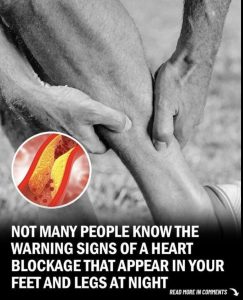When you think about signs of heart trouble or clogged arteries, symptoms like chest pain, shortness of breath, or high blood pressure probably come to mind first. But what if one of the earliest messengers of serious cardiovascular issues was right at your feet—literally? It turns out your feet might be trying to alert you to problems long before you’d ever think to get your heart checked. Though we often overlook them, our feet can be one of the first parts of the body to show signs of serious conditions like peripheral artery disease (PAD) and coronary artery disease (CAD), both of which are forms of atherosclerosis—a condition where plaque builds up in the arteries and restricts blood flow.

Peripheral artery disease occurs when the arteries that supply blood to your limbs become narrowed or blocked due to plaque buildup. This buildup—made up of fat, cholesterol, and other substances—hardens the arteries and limits blood circulation, particularly to your legs and feet. This reduced blood flow can trigger noticeable symptoms in the feet that may seem unrelated to the heart at first glance. According to WebMD and other health authorities, early signs of PAD that show up in your feet may include cold feet, even in warm weather, because poor circulation keeps warm blood from reaching your extremities.
Another red flag is slow-healing wounds. Cuts or blisters on your feet that take forever to heal may be a sign that there’s not enough blood flowing to repair tissue. Pain or cramping while walking, especially in your calves or feet, that goes away when you rest, can also point to PAD. Discoloration—such as pale, bluish, or purple tones in the skin—could also mean reduced blood flow. If you ignore these signs, PAD can progress into critical limb ischemia, a dangerous condition that may lead to infection, gangrene, and even amputation if left untreated. What’s even more concerning is that people with PAD often have atherosclerosis in other major arteries, including those that supply blood to the heart and brain, meaning they could also be at risk for more life-threatening issues.
Coronary artery disease is another major type of atherosclerosis that affects the arteries responsible for delivering oxygen-rich blood to your heart. As plaque builds up in these arteries, your heart gets less of the blood it needs to function properly, increasing the risk of heart attacks. While CAD is centered around the heart, it can still affect your feet in surprising ways. People with CAD may experience swelling, also known as edema, in the feet and ankles due to the heart’s reduced ability to pump blood efficiently. Tingling or numbness in the toes may develop because of limited blood circulation. You might notice the skin on your feet becoming shiny or unusually tight, a result of fluid retention and poor circulation. Some people even experience persistent foot pain while resting—particularly at night—which sets it apart from PAD-related pain that usually occurs during physical activity.
Brittle toenails are another less-known but possible symptom. When your toes don’t get enough blood, the nails can weaken, becoming thick, dry, or easily cracked. According to the American Heart Association, CAD is not just an adult issue anymore—children and teenagers are increasingly at risk due to poor diet, sedentary lifestyles, and obesity. That’s why early prevention is more important than ever. The AHA emphasizes that healthy eating habits, maintaining a good weight, and engaging in regular physical activity can delay or even reverse the development of CAD. And here’s a major insight: if you’re diagnosed with either PAD or CAD, there’s a strong likelihood that you actually have both, as these conditions often go hand in hand. So, what can you do to protect your feet—and more importantly—your heart? Taking proactive steps now can save you from serious complications down the road. Start by staying active. Regular exercise improves circulation and helps keep your arteries clear of plaque. The Centers for Disease Control and Prevention recommends at least 30 minutes of moderate physical activity, such as brisk walking or swimming, most days of the week.
Eating the right foods also plays a huge role. A heart-healthy diet includes plenty of fruits, vegetables, whole grains, and lean proteins. Try to cut down on highly processed foods, sugar, and saturated fats. If you smoke, quitting is absolutely essential. Smoking causes your blood vessels to narrow and stiffen, which worsens circulation and significantly increases your risk for both PAD and CAD. Managing stress is another vital part of protecting your heart. Chronic stress contributes to high blood pressure and inflammation, both of which are linked to heart disease.
Make time for calming practices like deep breathing, meditation, or simply enjoying a peaceful walk in nature. For those with diabetes, keeping blood sugar levels under control is critical. High blood sugar can damage blood vessels and nerves, leading to severe complications in both your feet and your cardiovascular system. Lastly, don’t skip your regular doctor’s appointments—especially if you have risk factors such as high blood pressure, high cholesterol, diabetes, or a family history of heart disease.
Early detection can make all the difference in managing or even reversing these conditions. Your feet might not say a word, but they could be shouting for help. Cold feet, unusual swelling, cramping, slow-healing wounds—these signs are more than just minor annoyances. They could be urgent messages from your body, warning you of deeper issues that need attention. The sooner you listen, the better your chances of staying healthy. So, were you surprised to learn just how connected your feet are to your heart? Don’t keep this important information to yourself—share it with your friends and family. You never know who might need to hear it and take action before it’s too late.





